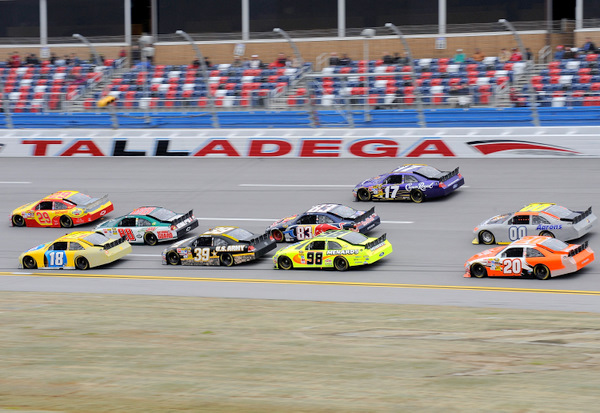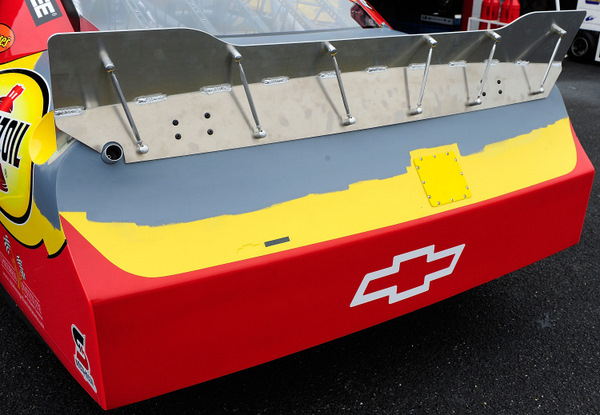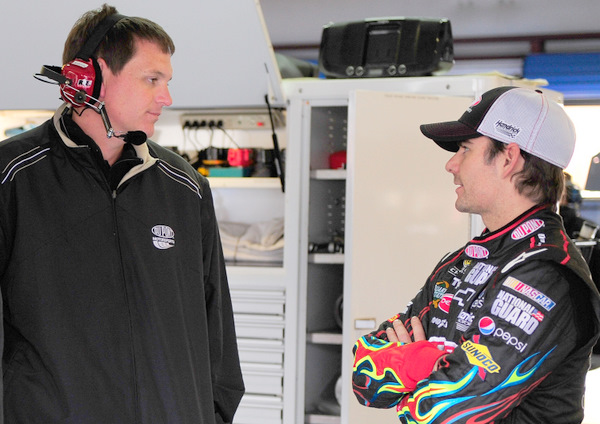Talladega testing: pretty darned fast, with the new package

Talladega test of NASCAR new 'old' flat-blade spoiler and new, bigger plate rules (Photo: Getty Images for NASCAR)
By Mike Mulhern
mikemulhern.net
How fast is too fast?
That was a quick issue during Tuesday's test of new spoiler and restrictor plate rules at Talladega for next month's 500, during a special test at Talladega Superspeedway involving 24 Sprint Cup drivers.
Juan Pablo Montoya's pole qualifying run for last spring's Talladega race was 188.171 mph. But Jimmie Johnson, in a morning single-run session, hit 196.467 mph, and teammate Jeff Gordon also topped 196.
And in the afternoon drafting speeds were well over 200 mph, from 208 mph to 210 mph.
Typically NASCAR has tried to keep draft speeds at Daytona and Talladega well under 200 mph, for safety concerns. NASCAR has put restrictions on cars at the two tracks since Bobby Allison's frightening rip through the front-stretch fencing in 1988. However a scary similar incident in last spring's Talladega 500, when Carl Edwards' car got airborne in a battle with Brad Keselowski for the win on the last lap, has led to some rethinking of aerodynamics at the two fast tracks.
NASCAR is dropping the odd-looking rear wing and returning to the venerable flat-blade rear spoiler, beginning at Martinsville next week, with a major test of the new aerodynamic package also set for next week at Charlotte Motor Speedway.
The flat blade spoiler may keep the cars from getting airborne when they get turned around. Roof flaps have proven somewhat ineffective in some recent flipping crashes with the winged cars, as Keselowski's crash last week at Atlanta showed. His car turned backwards and became airborne, after being hit by Edwards, and Keselowski's car landed on its roof.
That incident was eerily similar to the Edwards-Keselowski crash at Talladega last April.
NASCAR is also trying to open up the engine power for drivers at Talladega, as it did at Daytona, with a larger restrictor plate.

New spoiler looks a bit over-engineered (Photo: Getty Images for NASCAR)
However results of the one-day test were inconclusive, and NASCAR officials said they'll ponder the test data before deciding on a specific restrictor plate size and rear spoiler size for the Talladega 500.
Drivers got plates with large holes to begin the testing, four holes 1-1/32ths of an inch in diameter, considerably larger than used lately at the stock car tour's fastest track. That created a rather quick closing rate for drivers in the draft, and NASCAR cut the plate size. Drivers wound up the session with plates with holes sized at 31/32ths of an inch.
Robin Pemberton, NASCAR's competition director: "We saw the closure rates were a little too quick in the initial drafting session (in the afternoon). So we had teams make some adjustments, going down on the plate size and trimming the spoiler back some."
The height of the new rear spoiler was an issue, with drivers wanting a shorter rear spoiler (less drag).
Kurt Busch said trimming the rear spoiler would be his recommendation "because right now the lead car can get out there, but he can't go anywhere. And it invites everybody else to suck up really easy."
Pemberton said the session went well overall: "We believe we came away with a good starting point."
Rear end gearing may be an point to consider too. NASCAR allows teams a couple of different rear end gears for Talladega, to limit RPM, and that may be the next move before the 500.
One reason for the NASCAR rules shakeups, and it's new 'boys, have at it' approach to self-policing on the track, stems to the Talladega race last fall, when drivers were open about racing single-file much of the afternoon rather than dicing it up, because they didn't want to get involved in a big crash early. Of course the big crash eventually happened, late, and it was similarly frightening to last spring's crashing.
Gordon says this time at Talladega, well, just what to expect? "You're still going to have guys with strategies of wanting to be at the front, versus maybe wanting to hang in the back," Gordon said.
"You're still going to see some big pile-ups, bump-drafting, a lot of passing for the lead....
"The last race (at Talladega last fall) they (fans) were criticizing the single-file racing during the middle, but that's just because it's 500 miles and you got to make it to the end. Then all the action's going to happen."
And just how aggressive might drivers be at Talladega? In light of the fallout from Edwards-Keselowski Atlanta brouhaha, that's unclear.
Gordon: "We're really going to put that to the test -- just how aggressive we can be bump-drafting.
"You throw the (new) spoiler in there, the (new) restrictor plate...that's definitely going to make things challenging, and interesting, from a driver standpoint -- how we're going to work those things, what it's going to take to win the race and stay out of trouble at the same time.
"This is really where it's going to be put to the test; not Daytona. So we didn't see a whole lot of change and difference at Daytona, but we definitely will when we come here.
"What's going to be the biggest challenge is trying to figure out if we can do that with this car."
Gordon says he's not sorry to see the wing dropped. "I was never crazy about the way the wing was mounted on the back of the car. When I envision a wing being put on our car, I envisioned it a little bit more like a TransAm car -- more of a cool-looking concept, making the cars a little bit more futuristic.
"But the wing we put on was just a glorified spoiler. It wasn't very appealing. We weren't really using it efficiently.
"This car looks good with a (flat-blade) spoiler on it."
[Note: You can use Twitter as an easy headline service for mikemulhern.net stories, with our instant Tweets to your mobile as soon as our newest NASCAR story is filed. And mikemulhern.net is mobile-friendly for viewing. You can also use the orange RSS feed button as a quickie headline service on your laptop or home computer for mikemulhern.net stories, by creating a Live Bookmark RSS feed on your web browser's toolbar. Or you can create a Google Alert for mikemulhernnet.]

Jeff Gordon (R, with crew chief Steve Letarte) says he was never a big fan of the winged spoiler (Photo: Getty Images for NASCAR)
© 2010-2011 www.mikemulhern.net All rights reserved.
Web site by www.webdesigncarolinas.com







Give It Up On The Larger Plate
The more horsepower NASCAR allows the faster they'll go. How many times will we see this farce of a larger plate then going to a smaller plate before NASCAR gives up on the myth of throttle response? They race perfectly fine without it, and the cars do not need to flirt with 200; 190 in the draft is enough. NASCAR needs to go to a smaller plate and start mandating it for Atlanta et al and stick with it. 190 is the proven safety cut-off point; Rusty Wallace years ago noted this with regard to the roof flaps.
The airborne melees of recent are a speed issue, not a wing issue - these things tumbled like mad the last time they had spoilers.
atlanta with plates! now I
atlanta with plates! now I like the idea....but selling the drivers.....i think dale jr even hit 213 mph at talladega tuesday, and said he couldnt tell the difference.....
hey, you're good on history -- let's go over some of these airborne crashes over the years and analyze them....i'm opening up my history books right now....
Reply to comment
Links To A Few
Click on each line for the link.
Skinner in the Charlotte Truck race.
Micky Hudspeth at Atlanta in 1996.
Steve Grissom flips after tearing open the concrete at Atlanta in 1997.
Johnny Benson tumbles at Michigan in 1993.
Elliott Sadler tumbles at Michigan in 1999.
Mike Bliss tore open over 40 feet of fencing at Bristol in this 1996 flip.
Wrong
Please pardon STP43FAN, he's clearly mentally handicapped.
A plate at any other track other than Talladega will make the race a parade. Remember the debacle at New Hampshire in 2000?
What NASCAR needs to do is accelerate the idea of the Nationwide COT and apply it to these other tracks, except go further. Make them have harsher body panel lines and nose lines so that they would look like their street counterparts. Put them through the wind tunnels to aero-match their drag numbers and put them on the track. The current COT, even with the big ugly splitter, is still too slick in the draft. I hate the 31/32 plate, but if they don't dirty the cars up a little more, we're stuck with it.
Uh, I'll let you and ol' 43
Uh, I'll let you and ol' 43 duke it out between the haulers.....(remember when Darrell Waltrip used to get real worried when then-crew-chief Buddy Parrott would take off his glasses and hand them to DW and say 'Hold these for a second, bud....'? lol)
that plate race at loudon was an anomoly, with drivers threatening a boycott if nascar didnt do something....so how much weight to put in that race, i'm not sure. but, yes, plates at some tracks -- maybe loudon and phoenix -- might not work, but at other tracks -- say, california -- maybe plates would. i've been trying to get gillian zucker, who runs ACS in Fontana to put some plates on cars and test the idea, but nascar keeps nixing it. if it's not nascar's idea, they don't like it....
yes, you're right about getting those new nationwide cars on the track. should have debuted at daytona last month....bad marketing call all the way around. who's going to buy a new car in july?
why dont you like the 31/32 -- what should they put on those things.
NH 2000 Was Not A Debacle
Anonymous needs to bring something more to the table before he lectures me about being mentally handicapped.
The race at New Hampshire in 2000 wasn't a great race, but it had nothing to do with restrictor plates, otherwise the Modifieds that race there would never see any kind of passing, because they run restrictor plates and have done so since they started there in 1990. Nor would the Busch North cars (which were also plated that weekend) have seen any passing, yet the lead changed several times that race (I was at that weekend for both Saturday and Sunday races). And for all the chest-thumping the 300-miler did see a spectacular 25-car battle third on back in the opening ten laps.
The reality is lack of downforce, aeropush, and weakness of the draft impeded passing - restrictor plates did nothing to impede passing; they never have - anywhere.
The street counterparts argument is looney tunes. The new BGN cars look alike - that stubborn form following function reality again - and all the experience of the Trucks, the COT, etc. has shown that you can't dirty them up without bolting a blade on the roof like in 2001. The 31/32 plate is too large - drop to a 7/8.
The reality you have to face is the plates are permanent and needed for the other tracks - especially in the wake of Keselowski's tumble.
Hmmm....
Has NASCAR ever wind tunneled the race cars "sideways" at 200+ mph to see how the wind effects the car? I would think so with the addition of the roof flaps, but I'm not sure they even done that. Just that aviation recommendation from Jack Roush on roof flaps and it was good enough for them.
I agree
They race perfectly fine without it, and the cars do not need to flirt with 200; 190 in the draft is enough. NASCAR needs to go to a smaller plate and start mandating it for Atlanta et al and stick with it. 190 is the proven safety cut-off point; Rusty Wallace years ago noted this with regard to the roof flaps cavalier car parts.